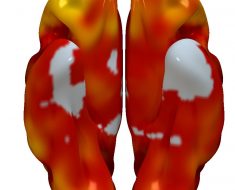
- A recent study developed a way to combine data from lung cancer screening with artificial intelligence (AI) to help predict the risk of death from heart disease.
- The study’s calcium scoring method predicted cardiovascular mortality risk comparably to standard methods.
- According to the authors, their method is “automatic, fast, and only cause[s] minimal extra workload.”
Smoking
Chemicals in cigarette smoke damage the lining of the blood vessels, leading to inflammation. Smoking can also contribute to atherosclerosis or the accumulation of plaque (composed of fat, calcium, and other substances), causing arterial narrowing and stiffness.
A
The 2021 United States Preventative Services Task Force (USPSTF) currently recommends annual lung cancer screening with low-dose CT in adults aged 50–80 years of age who have a 20
The authors of the recent study examined whether doctors could use these recommended lung screenings to predict the 5-year risk for heart disease-related deaths.
Deep learning method
The study findings appear in the journal Radiology: Cardiothoracic Imaging. The study used low-dose CT lung scan data from participants enrolled in the National Lung Screening Trial between August 2002 and April 2004.
The study used an automatic deep learning method to quantify arterial calcium from the low-dose CT lung scans. Deep learning is a type of AI that uses a multi-layered structure of algorithms or “neural networks” to analyze data.
The first neural network aligns and crops the CT image to focus on the heart. The second neural network measures calcium levels in the images extracted from the first neural network.
The deep learning network identified blood vessel calcification in six different regions of the heart, including the thoracic aorta, aortic valve, mitral valve, and the right coronary artery.
Using this information, the authors predicted each participant’s 5-year CVD mortality. They then compared the study prediction model with three other models:
- self-reported participant characteristics only
- self-reported characteristics and total CAC
- self-reported characteristics and the study prediction model
The self-reported participant characteristics indicating increased CV risk included age, a history of smoking, and a history of other diseases, such as diabetes, stroke, high blood pressure, and heart disease.
Researchers trained the prediction model with data from 4,451 participants and tested it with data from 1,113 participants. Approximately 62% of the testing group were male, with a median age of 61 and a smoking history of about 50 pack-years.
The authors found that their automatic calcium scoring method performed equally at predicting 5-year CV mortality risk as the model using self-reported CV risk factors and total CAC.
The study prediction model performed better than the self-reported patient characteristics alone. The most accurate predictions came from the scientists’ new method in combination with self-reported participant characteristics.
Fast and automatic
Lead study author Dr. Bob D. de Vos, Ph.D., from Amsterdam University Medical Center in Amsterdam and the Image Sciences Institute, University Medical Center Utrecht, both in the Netherlands, comments on the advantages of the automatic calcium scoring study method:
“The method uses only image information, it is fully automatic, and it is fast. The method obtains calcium scores in a complete chest CT in less than half a second.”
Limitations of the study include that the study population consisted of heavy smokers of a specific age range who were predominantly male, which limits generalizability to other populations.
Dr. de Vos states, “We developed a method, for example, that can detect coronary calcifications even when the lesions are below the clinically used threshold. This way, we hope to increase the reproducibility of calcium scoring and enable more accurate prediction.”
“We also see that some people with very high calcium scores survive, while others with low scores do suffer from major cardiac events. The work offers a direction for future research to precisely pinpoint which calcifications are dangerous,” Dr. de Vos concludes.
Source: Read Full Article





